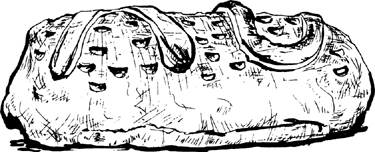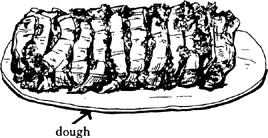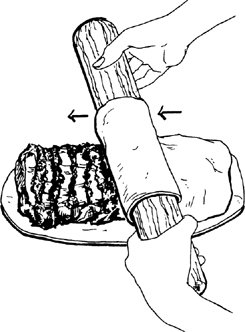Mastering the Art of French Cooking, Volume 2 (82 page)
Read Mastering the Art of French Cooking, Volume 2 Online
Authors: Julia Child

Filet de Boeuf en Croûte
[Tenderloin of Beef Baked in Pastry—Beef Wellington
Brioché
]
We do not know whether the English, the Irish, or the French baked the first
filet
of beef in a crust, but we can be certain that the French would not have named it after Wellington. It is a remarkably handsome, sumptuous dish when properly made. Most good recipes specify a whole piece of tenderloin that is preroasted 25 minutes, cooled, surrounded with a mushroom and
foie gras
stuffing, then wrapped in French puff pastry and baked. We think it a great improvement to substitute
brioche
dough for puff pastry: fully risen
brioche
dough is deflated, thoroughly chilled, then rolled thin, draped over the meat and baked immediately before the dough has a chance to rise again. The resulting crust is beautiful to look at as well as being light, thin, cooked all the way through and delicious to eat; this is never the case with puff pastry, which cannot bake properly under such circumstances and is always damply dumpling under its handsome exterior. Another improvement is to bake the tenderloin in slices with stuffing in between, as in the preceding recipe: the serving is easy and the taste is vastly improved.
VEGETABLE AND WINE SUGGESTIONS
An important dish like this should be surrounded with few distractions; we would suggest only something green and fresh like buttered new peas or green beans, broccoli flowerettes, or, in season, sliced, fresh, green asparagus spears tossed in butter. Again, a fine red Bordeaux-Médoc would be an excellent choice of wine.
THE SAUCE
Anything as extravagant as this
filet de boeuf
demands an unusually good sauce. We suggest 2 to 3 cups of the brown sauce or the
sauce ragoût
in Volume I, pages 67 and 69, simmered several hours for maximum flavor; it will then be further enriched with the cooking juices and deglazing wine from the beef, Step 1 in the following recipe.
For 16 slices of beef ½ inch thick, serving 8 to 10
1)
Preliminaries—to do in the morning or the day before serving
½ the recipe for
pain brioché
dough
(½ lb. flour)
One of the brown sauces described in preceding paragraph
2½ to 3 lbs. of the heart of the tenderloin, sliced, stuffed, wrapped and tied (
filet de boeuf en feuilletons
, Steps 1 and 2)
Rendered goose or pork fat, or cooking oil
A shallow roasting pan
½ cup dry port wine or Sercial Madeira
Prepare the dough as described, letting it finish its second rise in the refrigerator. Then deflate it, cover with plastic wrap, a plate, and a 5-pound weight (pieces of meat grinder) so that it will not rise again; refrigerate. Make the brown-sauce base and refrigerate. Prepare the stuffed
filet
as described, baste well
with fat or oil, and place in roasting pan. Preheat oven to 425 degrees, and set rack in upper-third level. Roast the beef for 25 minutes, basting and turning it several times. Transfer beef to a platter or tray (reserve roasting pan) and let meat cool to room temperature. (If you are preroasting a day ahead, cover and refrigerate the meat after it has cooled, but set at room temperature for 2 hours before final baking in Step 3, for accurate timing.) Spoon fat out of roasting pan, pour in wine and boil down by half, scraping up any roasting juices with a wooden spoon; scrape liquid into the sauce base.
2)
Enclosing beef in brioche—1 to 1½ hours before serving, and just before roasting
The cool, room-temperature, preroasted beef
Heavy shears
The chilled
brioche
dough
Flour, a rolling surface, a rolling pin, a ravioli wheel, a small knife
An oiled jelly-roll pan or pizza tray (raised edges needed to catch roasting juices)
Egg glaze (1 egg beaten with 1 tsp water in a small bowl)
A pastry brush
Optional: a meat thermometer
Preheat oven to 425 degrees and slide rack onto lower-middle level. Set out all the equipment and ingredients listed. Cut wrapping and string from beef. Working rapidly from now on so that
brioche
dough softens as little as possible, roll ¼ of the dough into a rectangle ¼ inch thick and the length and width of the beef. Roll it up on your pin and unroll it onto the oiled pan.
| Its most attractive side up, place the beef on the rectangle of dough |
Roll the remaining dough into a rectangle ¼ inch thick and large enough to enclose beef (probably 18 by 8 inches), roll it up on your pin and |
|





